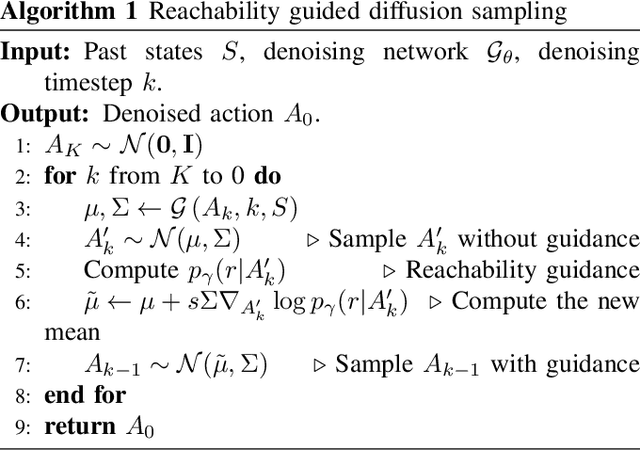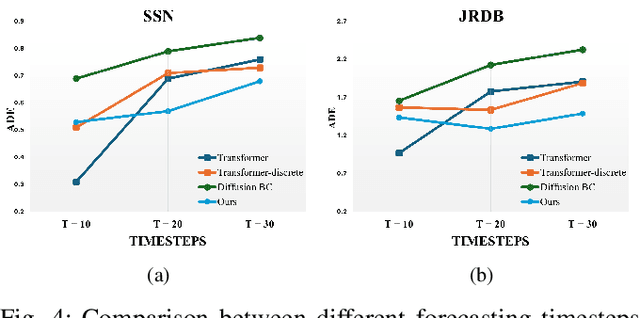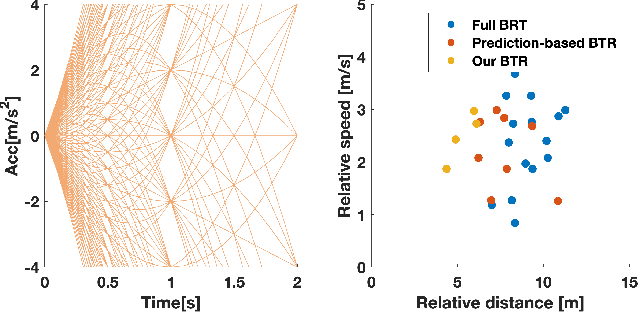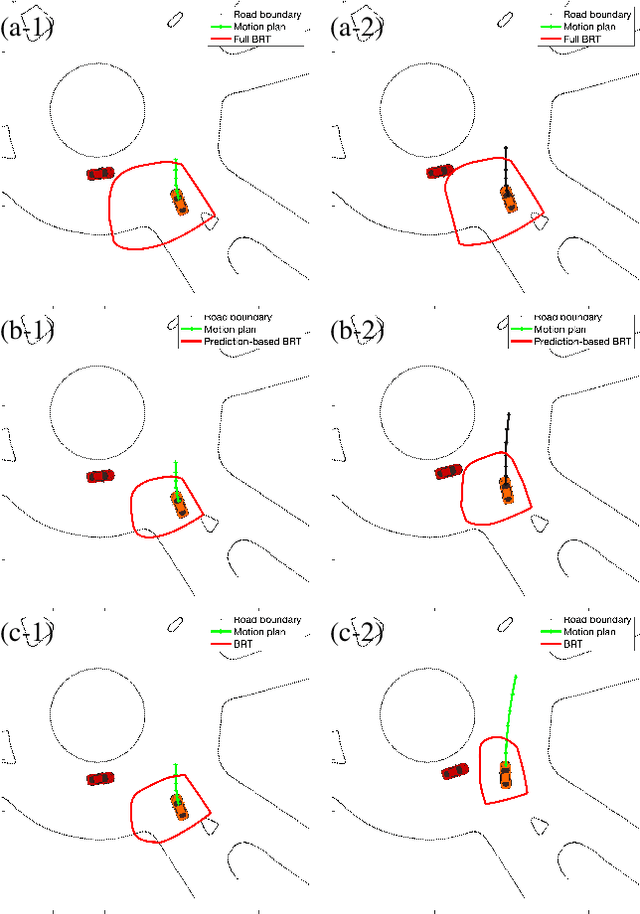Anjian Li
Aligning Diffusion Model with Problem Constraints for Trajectory Optimization
Apr 01, 2025Abstract:Diffusion models have recently emerged as effective generative frameworks for trajectory optimization, capable of producing high-quality and diverse solutions. However, training these models in a purely data-driven manner without explicit incorporation of constraint information often leads to violations of critical constraints, such as goal-reaching, collision avoidance, and adherence to system dynamics. To address this limitation, we propose a novel approach that aligns diffusion models explicitly with problem-specific constraints, drawing insights from the Dynamic Data-driven Application Systems (DDDAS) framework. Our approach introduces a hybrid loss function that explicitly measures and penalizes constraint violations during training. Furthermore, by statistically analyzing how constraint violations evolve throughout the diffusion steps, we develop a re-weighting strategy that aligns predicted violations to ground truth statistics at each diffusion step. Evaluated on a tabletop manipulation and a two-car reach-avoid problem, our constraint-aligned diffusion model significantly reduces constraint violations compared to traditional diffusion models, while maintaining the quality of trajectory solutions. This approach is well-suited for integration into the DDDAS framework for efficient online trajectory adaptation as new environmental data becomes available.
End-to-End Predictive Planner for Autonomous Driving with Consistency Models
Feb 12, 2025Abstract:Trajectory prediction and planning are fundamental components for autonomous vehicles to navigate safely and efficiently in dynamic environments. Traditionally, these components have often been treated as separate modules, limiting the ability to perform interactive planning and leading to computational inefficiency in multi-agent scenarios. In this paper, we present a novel unified and data-driven framework that integrates prediction and planning with a single consistency model. Trained on real-world human driving datasets, our consistency model generates samples from high-dimensional, multimodal joint trajectory distributions of the ego and multiple surrounding agents, enabling end-to-end predictive planning. It effectively produces interactive behaviors, such as proactive nudging and yielding to ensure both safe and efficient interactions with other road users. To incorporate additional planning constraints on the ego vehicle, we propose an alternating direction method for multi-objective guidance in online guided sampling. Compared to diffusion models, our consistency model achieves better performance with fewer sampling steps, making it more suitable for real-time deployment. Experimental results on Waymo Open Motion Dataset (WOMD) demonstrate our method's superiority in trajectory quality, constraint satisfaction, and interactive behavior compared to various existing approaches.
Global Search of Optimal Spacecraft Trajectories using Amortization and Deep Generative Models
Dec 28, 2024



Abstract:Preliminary spacecraft trajectory optimization is a parameter dependent global search problem that aims to provide a set of solutions that are of high quality and diverse. In the case of numerical solution, it is dependent on the original optimal control problem, the choice of a control transcription, and the behavior of a gradient based numerical solver. In this paper we formulate the parameterized global search problem as the task of sampling a conditional probability distribution with support on the neighborhoods of local basins of attraction to the high quality solutions. The conditional distribution is learned and represented using deep generative models that allow for prediction of how the local basins change as parameters vary. The approach is benchmarked on a low thrust spacecraft trajectory optimization problem in the circular restricted three-body problem, showing significant speed-up over a simple multi-start method and vanilla machine learning approaches. The paper also provides an in-depth analysis of the multi-modal funnel structure of a low-thrust spacecraft trajectory optimization problem.
Learning Optimal Control and Dynamical Structure of Global Trajectory Search Problems with Diffusion Models
Oct 03, 2024



Abstract:Spacecraft trajectory design is a global search problem, where previous work has revealed specific solution structures that can be captured with data-driven methods. This paper explores two global search problems in the circular restricted three-body problem: hybrid cost function of minimum fuel/time-of-flight and transfers to energy-dependent invariant manifolds. These problems display a fundamental structure either in the optimal control profile or the use of dynamical structures. We build on our prior generative machine learning framework to apply diffusion models to learn the conditional probability distribution of the search problem and analyze the model's capability to capture these structures.
Constraint-Aware Diffusion Models for Trajectory Optimization
Jun 03, 2024



Abstract:The diffusion model has shown success in generating high-quality and diverse solutions to trajectory optimization problems. However, diffusion models with neural networks inevitably make prediction errors, which leads to constraint violations such as unmet goals or collisions. This paper presents a novel constraint-aware diffusion model for trajectory optimization. We introduce a novel hybrid loss function for training that minimizes the constraint violation of diffusion samples compared to the groundtruth while recovering the original data distribution. Our model is demonstrated on tabletop manipulation and two-car reach-avoid problems, outperforming traditional diffusion models in minimizing constraint violations while generating samples close to locally optimal solutions.
Predicting Long-Term Human Behaviors in Discrete Representations via Physics-Guided Diffusion
May 29, 2024



Abstract:Long-term human trajectory prediction is a challenging yet critical task in robotics and autonomous systems. Prior work that studied how to predict accurate short-term human trajectories with only unimodal features often failed in long-term prediction. Reinforcement learning provides a good solution for learning human long-term behaviors but can suffer from challenges in data efficiency and optimization. In this work, we propose a long-term human trajectory forecasting framework that leverages a guided diffusion model to generate diverse long-term human behaviors in a high-level latent action space, obtained via a hierarchical action quantization scheme using a VQ-VAE to discretize continuous trajectories and the available context. The latent actions are predicted by our guided diffusion model, which uses physics-inspired guidance at test time to constrain generated multimodal action distributions. Specifically, we use reachability analysis during the reverse denoising process to guide the diffusion steps toward physically feasible latent actions. We evaluate our framework on two publicly available human trajectory forecasting datasets: SFU-Store-Nav and JRDB, and extensive experimental results show that our framework achieves superior performance in long-term human trajectory forecasting.
Efficient and Guaranteed-Safe Non-Convex Trajectory Optimization with Constrained Diffusion Model
Feb 22, 2024



Abstract:Trajectory optimization in robotics poses a challenging non-convex problem due to complex dynamics and environmental settings. Traditional numerical optimization methods are time-consuming in finding feasible solutions, whereas data-driven approaches lack safety guarantees for the output trajectories. In this paper, we introduce a general and fully parallelizable framework that combines diffusion models and numerical solvers for non-convex trajectory optimization, ensuring both computational efficiency and constraint satisfaction. A novel constrained diffusion model is proposed with an additional constraint violation loss for training. It aims to approximate the distribution of locally optimal solutions while minimizing constraint violations during sampling. The samples are then used as initial guesses for a numerical solver to refine and derive final solutions with formal verification of feasibility and optimality. Experimental evaluations on three tasks over different robotics domains verify the improved constraint satisfaction and computational efficiency with 4$\times$ to 22$\times$ acceleration using our proposed method, which generalizes across trajectory optimization problems and scales well with problem complexity.
Amortized Global Search for Efficient Preliminary Trajectory Design with Deep Generative Models
Aug 07, 2023Abstract:Preliminary trajectory design is a global search problem that seeks multiple qualitatively different solutions to a trajectory optimization problem. Due to its high dimensionality and non-convexity, and the frequent adjustment of problem parameters, the global search becomes computationally demanding. In this paper, we exploit the clustering structure in the solutions and propose an amortized global search (AmorGS) framework. We use deep generative models to predict trajectory solutions that share similar structures with previously solved problems, which accelerates the global search for unseen parameter values. Our method is evaluated using De Jong's 5th function and a low-thrust circular restricted three-body problem.
Negotiation-Aware Reachability-Based Safety Verification for AutonomousDriving in Interactive Scenarios
Jun 04, 2021

Abstract:Safety assurance is a critical yet challenging aspect when developing self-driving technologies. Hamilton-Jacobi backward-reachability analysis is a formal verification tool for verifying the safety of dynamic systems in the presence of disturbances. However, the standard approach is too conservative to be applied to self-driving applications due to its worst-case assumption on humans' behaviors (i.e., guard against worst-case outcomes). In this work, we integrate a learning-based prediction algorithm and a game-theoretic human behavioral model to online update the conservativeness of backward-reachability analysis. We evaluate our approach using real driving data. The results show that, with reasonable assumptions on human behaviors, our approach can effectively reduce the conservativeness of the standard approach without sacrificing its safety verification ability.
Prediction-Based Reachability for Collision Avoidance in Autonomous Driving
Nov 24, 2020



Abstract:Safety is an important topic in autonomous driving since any collision may cause serious damage to people and the environment. Hamilton-Jacobi (HJ) Reachability is a formal method that verifies safety in multi-agent interaction and provides a safety controller for collision avoidance. However, due to the worst-case assumption on the car's future actions, reachability might result in too much conservatism such that the normal operation of the vehicle is largely hindered. In this paper, we leverage the power of trajectory prediction, and propose a prediction-based reachability framework for the safety controller. Instead of always assuming for the worst-case, we first cluster the car's behaviors into multiple driving modes, e.g. left turn or right turn. Under each mode, a reachability-based safety controller is designed based on a less conservative action set. For online purpose, we first utilize the trajectory prediction and our proposed mode classifier to predict the possible modes, and then deploy the corresponding safety controller. Through simulations in a T-intersection and an 8-way roundabout, we demonstrate that our prediction-based reachability method largely avoids collision between two interacting cars and reduces the conservatism that the safety controller brings to the car's original operations.
 Add to Chrome
Add to Chrome Add to Firefox
Add to Firefox Add to Edge
Add to Edge